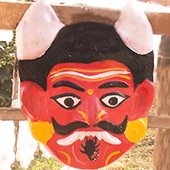Design Resource
Drishti Gombe Making - Bengaluru, Karnataka
Evil Force Defender
by
Prof. Bibhudutta Baraland Hariharasudan T.
“Eye is the window to the Soul”. Perhaps the real truth is that it is the window of intent. The eye is our most powerful organ in social interaction. We are fixated on it, and we use it against others to show our emotion. The evil eye is a human look believed to cause harm to someone or something else. The supernatural harm may come in the form of anything from a minor misfortune to disease, injury or even death. The best way to understand the concept of evil eye is to accept the idea of auras. Every human being has an aura around him or her. This is known as the subtle body. It is a kind of energy shield emerging from our physical and mental health status. There are various layers of aura that flows around our body. When the flow is blocked, disturbed or restricted by the negative energy, it causes ill effects.
Attempt to ward off the curse of the evil eye has resulted in a number of talismans in many cultures. Disks or balls consisting of concentric blue and white circles representing an evil eye are common apotropaic talismans in West Asia, Mediterranean regions. In Turkey it’s known as Nazar found in or on houses and vehicles. The blood-red demonic face with horns, smiling at you with a menacing glee which is visible on house terraces and construction sites, and on almost every truck, lorry and auto rickshaw in varying styles is nothing but a Drishti doll/ Drishti Gombe. This doesn’t have a discovery date, the custom of hanging a Drishti Gombe is centuries old and has been passed on from generation to generation with almost no variations, which is unique to India. This belief rests not only in India, but also among the people of the Latin America, West Africa, Central Asia, Europe and Mediterranean countries. Legend has that this belief had its genesis amongst the ancient Egyptians and Sumerians.
Custom is that by hanging the Drishti Gombe or doll in India or blue eye symbol in Mediterranean countries, it protects the owner from misfortune and jealous onlookers and wards off the evil eyes. In turkey people believe that a symbol in the same shape as an evil force can deflect the evil away, much like the best antidotes to snake poison are often made from the poison itself. The Evil Eye has such a long and broad history that it is hard to tie it to one religion. There are references to the Evil Eye in Sumerian cuneiform texts from 3,000 BC, from where it became the Hebrew ‘ayin harah, the Greek baskania and the Roman fascinatio. At the beginning of the modern era, thinkers such as Leonardo Da Vinci, Martin Luther, and Thomas Aquinas wrote about the Evil Eye in religious and scientific terms.
Here let us see how the drishti doll, which is seen all over India, is being made.





